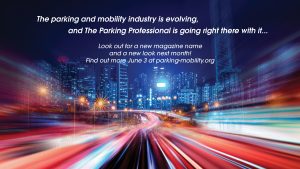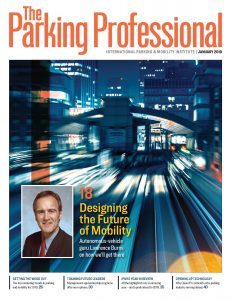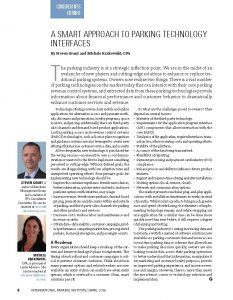 How one busy municipality solved the challenge of short-term downtown parking without alienating anyone, with great success.
How one busy municipality solved the challenge of short-term downtown parking without alienating anyone, with great success.
PARKING AVAILABILITY in a vibrant downtown is something most people entirely misunderstand. The general feeling is that there is not enough parking when space is not available right in front of the destination, but the reality in most cases is that there is ample parking, although a person may have to walk a block or two. It is also interesting to note that folks will typically walk farther than this when parking to shop at an indoor shopping mall. It is all in perception.
I have been asked the following questions more than any others when it comes to parking in the central downtown:
- But my meter has been fed all day—why did I get a ticket?
- Why can’t my employees or I park in front of my business for the day?
- Why can’t my tenants keep their vehicles parked in front of their apartments in the downtown?
I want to dive into these questions to clarify why it is important to have parking regulations when the desire is to have a thriving downtown business district. Finding a solution to parking problems is not always an easy task. The process can sometimes take months and, as you can see in the case of Morgantown, W.V., years of trial and error.
The Beginning
I want to start in November 1996 when I began my career with the Morgantown Parking Authority. At that time parking on High Street, Morgantown’s main street for businesses, was regulated from 9 a.m. to 6 p.m., Monday through Friday; 10 a.m. to 4 p.m. on Saturdays; and Sundays were free. The problem businesses faced at that time was when their shops would open at 10 a.m., there were no parking spaces available on High Street for their customers—those prime spots were already taken by business owners, employees, and those living in the downtown.
With the City of Morgantown bordering the West Virginia University campus, we continually face these unique parking challenges. Our journey began to try and find a solution to this problem. We started by meeting with the stakeholders in the downtown to receive input and ideas to try and find the right answers.
In August 1999, the Morgantown Parking Authority partnered with Main Street Morgantown to hire John D. Edwards, a transportation consultant out of Atlanta, Ga., to begin a parking study in Morgantown. Within that study, it was noted that there were currently time limits in place for short-term as well as long-term parking, but there was no provision in place to enforce the time limits. The study went on to say that as long as an individual continued to feed the meter, the vehicle could essentially stay in the same spot all day.
Edwards’ recommendation was to enforce the posted time limits, but why? Why does it matter who parks where and for how long? Through this study, we, as well as city stakeholders, began to understand how vital short-term parking was to the downtown business district. The study showed how imperative it is to have vehicle turnover to promote successful downtown businesses. Nationwide, parking studies show that 90 percent of people shopping, eating, or visiting the downtown stay for less than two hours. If business owners, employees, or people living in the downtown business district leave their vehicles parked long-term in this district on a daily basis, where will potential customers park?
Beginning Enforcement
After multiple meetings and continued complaints of vehicles being parked in prime spaces all day and taking up customer parking, the parking authority started monitoring the number of cars that were parking long-term in these areas. Throughout approximately two months, there were 17 vehicles noted using the short-term parking spaces for long-term parking on a daily basis. This information along with concerns from business owners was brought to the city council, and in November 2007, there was an ordinance amendment that would allow the parking time limits to be enforced. The information regarding the ordinance amendment was distributed through the local newspaper, radio, and television as well as written warnings being issued before this ordinance was enforced.
The penalties for parking long-term in a short-term space were a $5 ticket for being in a space longer than two hours even if the meter had not expired, then a $10 ticket if the vehicle remained in the space for an additional hour, and finally a $25 ticket if the vehicle stayed four or more consecutive hours. Essentially, a vehicle could receive $40 in parking tickets per day even if there was money in the meter for parking long-term in a short-term space.
This process worked for a while but did not wholly deter those that were abusing the short-term spaces, and some drivers eventually figured out that if they moved forward one parking space before their two hours were up, the parking authority would have to re-chalk the tires and start over with the timed parking.
Alternative Ideas
So back to the drawing board to find an alternative solution. With much discussion both internally and again with the downtown stakeholders affected by this issue, it was proposed to the city council to create a downtown parking zone with steeper fines to discourage the abuse:
- First, the hourly parking rate would increase from 75 cents per hour to $1 per hour.
- If a vehicle was parked in this zone more than two hours per day, a warning would be issued with information instructing the driver that they could not park in this zone longer than two hours.
- If the vehicle was seen again on a different day violating this ordinance, a $20 ticket would be issued.
- If this vehicle continued to park long-term, a $100 ticket would be issued each day for the remainder of the calendar year the vehicle continued to be parked in that zone.
The downtown parking zone was established by city council in July 2016 to reflect the changes. These changes have worked very well—customers can now find parking spaces in the downtown close to where they are shopping, doing business, eating, or visiting.
The one misconception about this ordinance is that if a customer comes to town to shop and later wants to come back for dinner, he or she will be cited for being in the parking zone for more than two hours per day. This is not true. First, a vehicle has to be seen parked for more than two hours in this zone on a regular basis before any action is taken. Then a warning is written with an explanation highlighted in bright pink on the bottom of the warning to inform the person that they cannot be in the zone for more than two hours a day. If the warning is ignored, then we begin to enforce the ordinance. As a side note, although the downtown parking zone was designed to enforce short-term parking regulations, there is sufficient long-term parking for business owners, employees, and residents of this zone.
Success
As I write this article, it has been two years since this ordinance has been in place, and out of the 80,000+ tickets that were written during this period, only 12 different vehicles have received the $100 ticket.
Why Does It Matter?
I want to return to the question I asked earlier: Why does it matter who parks where and for how long? Why can’t drivers continue to feed the meter all day? First, I want to state that from the parking authority’s perspective, it does not matter who parks in these spaces because every quarter is the same as the next. But, from the view of businesses in the downtown, it does matter who parks in these spaces and how many times a day these spaces turn over.
Why do these particular spaces need to be available for customers and patrons of the downtown? A piece written to Uptown Lexington, N.C., businesses from Uptown Lexington, Inc. in December 1998 stated that a recent study had shown that if a customer came to town, stayed 30 minutes and spent $5, then left, and the stores were open 40 hours a week, each space would be worth $17,000 a year in commerce. Most parking studies show that the downtown parking space should turn over between five and 10 times per day to be most beneficial for the businesses.
The downtown parking zone was not put in place to discourage parking in the downtown, but to encourage people to visit the city by opening up the most convenient parking spaces closest to their destinations. We are all creatures of habit, and we will circle the block or parking lot more than once trying to find the closest spot possible.
I should also mention that three out of five Morgantown Parking Authority Board members own businesses within the parking zone, and although there was some skepticism at the beginning of creating this zone, the owners, as well as their customers, agree that it is working. Those visiting the downtown can now find convenient parking spaces close to their destination.
In our efforts to open up spaces in the downtown parking zone, we also offer other options for those working or living in the downtown. There are discounted monthly parking permits for the gated parking garages that are one block from downtown, there are long-term parking lots, and we added a parking app in February 2018 to help make parking more convenient. There have been more than 60,000 transactions through the app since February. One of the best features of the app is that drivers get a text message 15 minutes before their meter time expires. They can choose to go back to their cars or add time on the app.
In my 20+ years with the Morgantown Parking Authority, we have made a point of regularly educating the public as to why we have the regulations that we have in place as well as doing regular reviews to see what is and what is not working. The goal of any successful public parking program should always be focused on the needs of all those involved. I know that it is impossible to make everyone happy, but at least they will always have a place to park!
Read the article here.
DANA MCKENZIE, CAPP, is executive director of the Morgantown, W.V., Parking Authority. He can be reached at dmckenzie@morgantownwv.gov.
36 THE PARKING PROFESSIONAL | FEBRUARY 2019 | PARKING-MOBILITY.ORG
By Dana McKenzie, CAPP
 By Kim Fernandez
By Kim Fernandez


 Talk about the future of mobility–specifically, shared, electric, autonomous vehicles–and it won’t be long before somebody brings Lawrence Burns into the conversation. That’s for good reason; before he wrote the bestseller “
Talk about the future of mobility–specifically, shared, electric, autonomous vehicles–and it won’t be long before somebody brings Lawrence Burns into the conversation. That’s for good reason; before he wrote the bestseller “